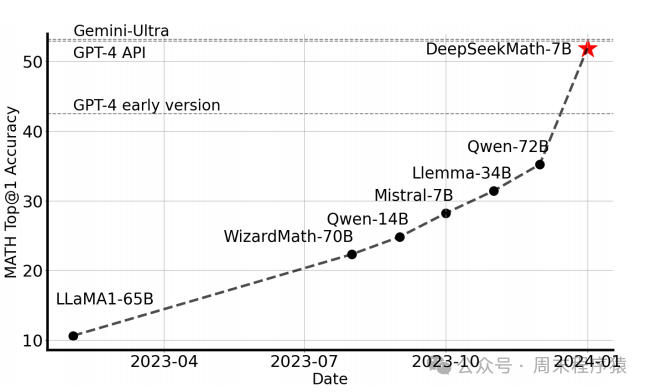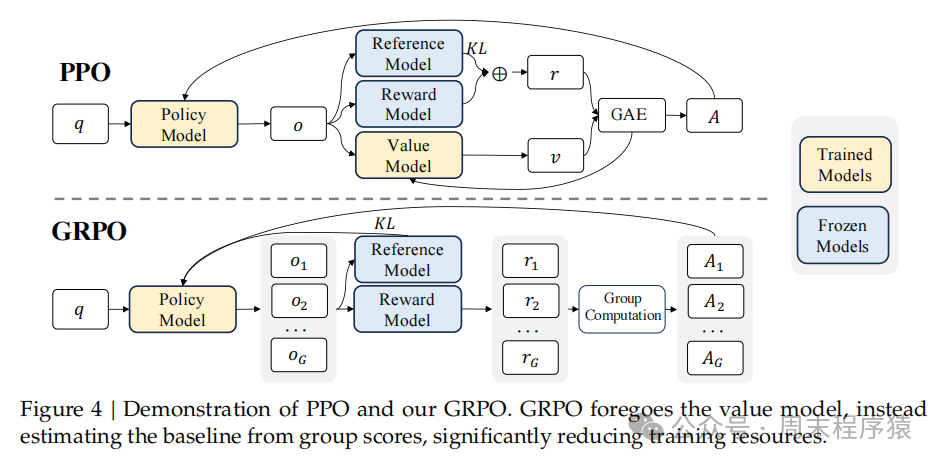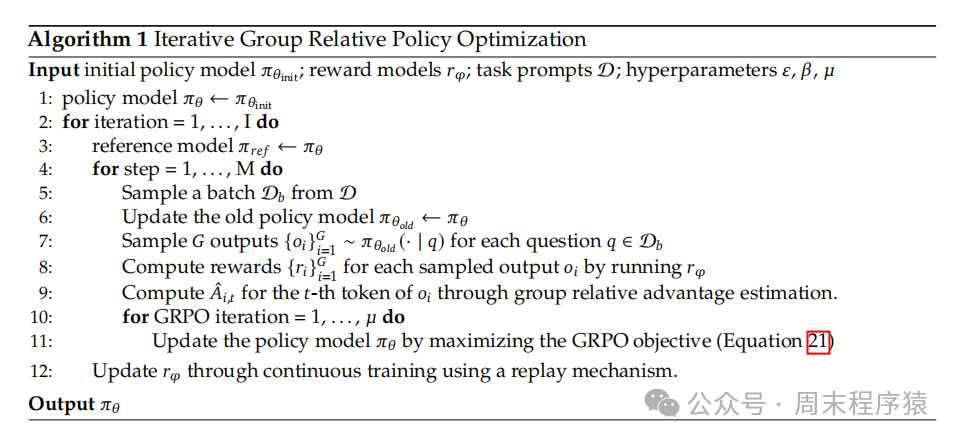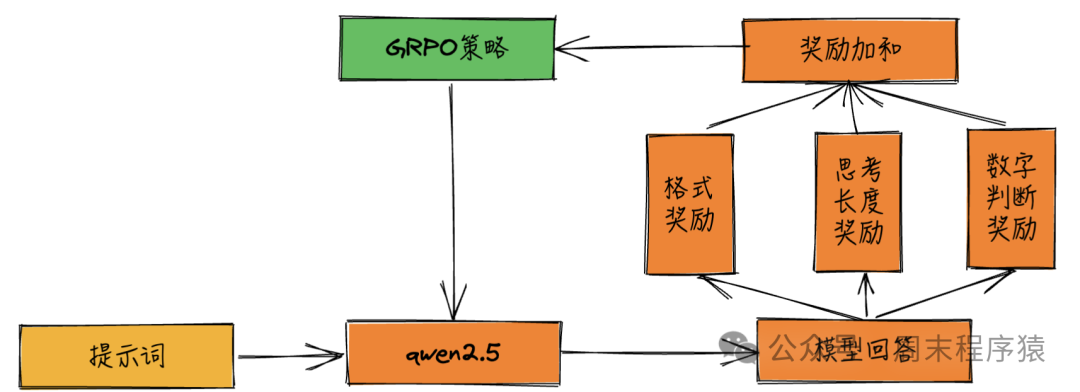机器学习 | 从0开发大模型之DeepSeek的GRPO
最近,DeepSeek-R1的发布为国产大模型争光了(太强了),不过 GRPO 算法源自 DeepSeekMath 7B 模型,该模型在 MATH 基准测试中取得了优异成绩,论文发表于2024年2月份:https://huggingface.co/papers/2402.03300,以下是该论文的摘要原文:
Mathematical reasoning poses a significant challenge for language models due to its complex and structured nature. In this paper, we introduce DeepSeekMath 7B, which continues pre-training DeepSeek-Coder-Base-v1.5 7B with 120B math-related tokens sourced from Common Crawl, together with natural language and code data. DeepSeekMath 7B has achieved an impressive score of 51.7% on the competition-level MATH benchmark without relying on external toolkits and voting techniques, approaching the performance level of Gemini-Ultra and GPT-4. Self-consistency over 64 samples from DeepSeekMath 7B achieves 60.9% on MATH. The mathematical reasoning capability of DeepSeekMath is attributed to two key factors: First, we harness the significant potential of publicly available web data through a meticulously engineered data selection pipeline. Second, we introduce Group Relative Policy Optimization (GRPO), a variant of Proximal Policy Optimization (PPO), that enhances mathematical reasoning abilities while concurrently optimizing the memory usage of PPO.翻译如下:
数学推理对语言模型构成了重大挑战,因为其复杂且结构化的特性。在本文中,我们介绍了DeepSeekMath 7B,它在DeepSeek-Coder-Base-v1.5 7B的基础上进行了继续预训练,使用了来自Common Crawl的120B与数学相关的标记,以及自然语言和代码数据。DeepSeekMath 7B在竞争级MATH基准测试中取得了51.7%的优异成绩,且未依赖外部工具包和投票技术,接近Gemini-Ultra和GPT-4的性能水平。DeepSeekMath 7B在64个样本上的自一致性达到了60.9%的MATH成绩。DeepSeekMath的数学推理能力归因于两个关键因素:首先,我们通过精心设计的数据选择流程,充分利用了公开可用的网络数据的巨大潜力。其次,我们引入了群体相对策略优化(GRPO),这是一种近端策略优化(PPO)的变体,旨在增强数学推理能力,同时优化PPO的内存使用。
对比数据
1、什么是GRPO
GRPO 是一种在线学习算法,核心思想是通过组内相对奖励来估计基线,从而避免使用额外的价值函数模型。通过在训练期间使用受训模型自身生成的数据来迭代改进,GRPO 旨在最大化生成补全的优势,同时确保模型保持接近参考策略,下图是论文中的算法流程图:

GRPO
GRPO 是 PPO (Proximal Policy Optimization,近端策略优化,是一种强化学习算法,由OpenAI于2017年提出,旨在解决策略梯度方法中的训练不稳定问题) 的变体,主要区别是:
- GRPO 省略 value function model
- GRPO 奖励计算,改成了一个 q 生成多个 r,然后 reward 打分
GRPO算法流程:
- 采样一组输出并计算每个输出的奖励
- 对组内奖励进行归一化处理
- 使用归一化后的奖励计算优势函数
- 通过最大化目标函数更新策略模型
- 迭代训练,逐步优化策略模型

论文中的伪代码
2、奖励设计
huggingface 库提供 GRPOTrainer 可以直接使用 GRPO 训练,参数包括定义奖励模型和函数。
2.1 奖励模型
trainer = GRPOTrainer(
model="Qwen/Qwen2.5-3B-Instruct",
reward_funcs="weqweasdas/RM-Gemma-2B",
args=training_args,
train_dataset=dataset,
peft_cnotallow=LoraConfig(task_type="CAUSAL_LM"),
)这里的 reward_funcs 参数可以传入奖励模型。
2.2 奖励函数
GRPOTrainer 允许用户自定义奖励函数,通过定义一个返回浮点数列表的函数来实现。
- 奖励函数的输入:completions(生成的补全)和 prompts(提示)
- 奖励函数的输出:返回一个浮点数列表,每个浮点数代表对应于单个补全的奖励
(1)较长补全奖励函数
def completion_reward(completions, **kwargs):
'''奖励函数,对较长的补全给予更高的分数'''
return [float(len(completion))/100 for completion in completions]
prompts = ["The sky is", "The sun is"]
completions = [" blue.", " in the sky."]
print("completion_reward: ", completion_reward(prompts=prompts, completinotallow=completions))(2)格式正确奖励函数
def format_reward(completions, **kwargs):
'''格式奖励'''
pattern = r"<think>.*?</think>\s*<answer>.*?</answer>"
responses = [completion[0]["content"] for completion in completions]
matches = [re.match(pattern, response) for response in responses]
return [0.5if match else0.0for match in matches]
prompts = [
[{"role": "assistant", "content": "What is the result of (1 + 2) * 4?"}],
[{"role": "assistant", "content": "What is the result of (3 + 1) * 2?"}],
]
completions = [
[{"role": "assistant", "content": "<think>The sum of 1 and 2 is 3, which we multiply by 4 to get 12.</think><answer>(1 + 2) * 4 = 12</answer>"}],
[{"role": "assistant", "content": "The sum of 3 and 1 is 4, which we multiply by 2 to get 8. So (3 + 1) * 2 = 8."}],
]
print("format_reward: ", format_reward(prompts=prompts, completinotallow=completions))根据以上的奖励样例,可以设计对于不同数据集的奖励函数,如:
- 判断内容中是否包含数字
- 判断内容回答是否参考网页的知识库内容
- ...
然后将这些函数传入 GRPOTrainer 即可,代码如下:
trainer = GRPOTrainer(
model=model,
processing_class=tokenizer,
reward_funcs=[
...
format_reward,
completion_reward,
],
args=training_args,
train_dataset=data,
...
)3、使用 GRPO 训练模型
github上已经有很多复刻 DeepSeek-R1-Zero 的方案,有兴趣可以看一下这几个开源项目(成本基本都控制在500以内):
3.1 训练代码
这里为了演示如何使用 GRPO 训练模型,本文也给出了完整的训练代码,其中流程如下:

- 使用Qwen/Qwen2.5-3B-Instruct 作为基础模型
- 使用swulling/gsm8k_chinese 作为训练数据集
import re
from datasets import load_dataset
from transformers import AutoModelForCausalLM, AutoTokenizer
from peft import LoraConfig
from trl import GRPOConfig, GRPOTrainer
SYSTEM_PROMPT = """
按照如下格式生成:
<think>
...
</think>
<answer>
...
</answer>
"""
def process_data(data):
return data.map(
lambda x: {
"prompt": [
{"role": "system", "content": SYSTEM_PROMPT},
{"role": "user", "content": x["question_zh-cn"]},
],
"answer": x["answer_only"],
}
)
def extract_answer(text):
answer = text.split("<answer>")[-1]
answer = answer.split("</answer>")[0]
return answer.strip()
def correctness_reward(completions, answer, **kwargs):
responses = [completion[0]["content"] for completion in completions]
extracted_responses = [extract_answer(r) for r in responses]
return [2.0if response == str(ans) else0.0for response, ans in zip(extracted_responses, answer)]
def completion_reward(completions, **kwargs):
'''奖励函数,对较长的补全给予更高的分数'''
return [float(len(completion)) / 100for completion in completions]
prompts = ["The sky is", "The sun is"]
completions = [" blue.", " in the sky."]
print("completion_reward: ", completion_reward(prompts=prompts, completinotallow=completions))
def digit_reward(completions, **kwargs):
responses = [completion[0]["content"] for completion in completions]
extracted_responses = [extract_answer(r) for r in responses]
return [0.5if response.isdigit() else0.0for response in extracted_responses]
def format_reward(completions, **kwargs):
'''格式奖励'''
pattern = r"<think>.*?</think>\s*<answer>.*?</answer>"
responses = [completion[0]["content"] for completion in completions]
matches = [re.match(pattern, response) for response in responses]
return [0.5if match else0.0for match in matches]
prompts = [
[{"role": "assistant", "content": "What is the result of (1 + 2) * 4?"}],
[{"role": "assistant", "content": "What is the result of (3 + 1) * 2?"}],
]
completions = [
[{"role": "assistant", "content": "<think>The sum of 1 and 2 is 3, which we multiply by 4 to get 12.</think><answer>(1 + 2) * 4 = 12</answer>"}],
[{"role": "assistant", "content": "The sum of 3 and 1 is 4, which we multiply by 2 to get 8. So (3 + 1) * 2 = 8."}],
]
print("format_reward: ", format_reward(prompts=prompts, completinotallow=completions))
def mark_reward(completions, **kwargs):
'''标记奖励(改善格式奖励稀疏问题)'''
def mark_num(text):
reward = 0
if text.count("<think>\n") == 1:
reward += 0.125
if text.count("</think>\n") == 1:
reward += 0.125
if text.count("<answer>\n") == 1:
reward += 0.125
if text.count("</answer>\n") == 1:
reward += 0.125 * 2
return reward
responses = [completion[0]["content"] for completion in completions]
return [mark_num(response) for response in responses]
if __name__ == "__main__":
model_name = "Qwen/Qwen2.5-3B-Instruct"
model = AutoModelForCausalLM.from_pretrained(model_name, cache_dir="./model")
model.cuda()
tokenizer = AutoTokenizer.from_pretrained(model_name)
ds = load_dataset("swulling/gsm8k_chinese", cache_dir="./dataset")
data = process_data(ds["train"])
output_dir = "output"
training_args = GRPOConfig(
output_dir=output_dir,
learning_rate=5e-6,
adam_beta1=0.9,
adam_beta2=0.99,
weight_decay=0.1,
warmup_ratio=0.1,
lr_scheduler_type="cosine",
logging_steps=1,
bf16=True,
per_device_train_batch_size=1,
gradient_accumulation_steps=4,
num_generatinotallow=16,
max_prompt_length=256,
max_completion_length=200,
num_train_epochs=1,
save_steps=100,
max_grad_norm=0.1,
log_on_each_node=False,
use_vllm=False,
report_to="tensorboard",
)
trainer = GRPOTrainer(
model=model,
processing_class=tokenizer,
reward_funcs=[
mark_reward,
format_reward,
digit_reward,
completion_reward,
correctness_reward,
],
args=training_args,
train_dataset=data,
peft_cnotallow=LoraConfig(task_type="CAUSAL_LM"),
)
trainer.train()
trainer.save_model(output_dir)3.2 输出结果
(1)Qwen/Qwen2.5-3B-Instruct 输出:
用户:
使用给定的数字 [44, 19, 35],创建一个等于 98 的方程。你可以使用基本算术运算(+、-、*、/)一次或多次,但每个数字只能使用一次。在 <think> </think> 标签中展示你的思考过程,并在 <answer> </answer> 标签中返回最终方程,例如 <answer> (1 + 2) / 3 </answer>。在 <think> 标签中逐步思考。
机器人:
<span class="think">首先我们需要找到如何将给定的数字组合起来得到 98。我们可以尝试不同的组合,比如加法和减法。注意到 98 可以分解为 90 和 8 的和,因此我们可以考虑用 44 和 35 来构造这两个数。</span>
<span class="think">观察到 44 和 35 的差是 9,如果我们将 35 减去这个差,就可以得到 8。即 35 - (44 - 35) = 8。</span>
<span class="think">现在我们有了 8 和 90,可以将它们相加得到 98。所以最终的方程是 35 + (44 - 35)。</span>
<answer> 35 + (44 - 35) </answer>(2)训练的模型输出:
用户:
使用给定的数字 [44, 19, 35],创建一个等于 98 的方程。你可以使用基本算术运算(+、-、*、/)一次或多次,但每个数字只能使用一次。在 <think> </think> 标签中展示你的思考过程,并在 <answer> </answer> 标签中返回最终方程,例如 <answer> (1 + 2) / 3 </answer>。在 <think> 标签中逐步思考。
机器人:
<think>
首先,我需要使用数字44、19和35,通过基本算术运算(+、-、*、/)来构造一个等于98的方程,且每个数字只能使用一次。
我先考虑将较大的数字进行加法或乘法运算,以达到接近98的目标。例如,44加19等于63,再加上35可以得到98。具体计算如下:
44 + 19 = 63
63 + 35 = 98
因此,最终的方程可以表示为44 + 19 + 35 = 98。
</think>
<answer> 44 + 19 + 35 = 98 </answer>参考
(1)https://github.com/Jiayi-Pan/TinyZero
(2)https://github.com/huggingface/open-r1
(3)DeepSeek-R1: Incentivizing Reasoning Capability in LLMs via Reinforcement Learning(https://arxiv.org/pdf/2501.12948)
(4)https://zhuanlan.zhihu.com/p/20021693569
(5)https://zhuanlan.zhihu.com/p/19949917958
(6)https://blog.csdn.net/qq_38961840/article/details/145387854
本文转载自 周末程序猿,作者: 周末程序猿

















